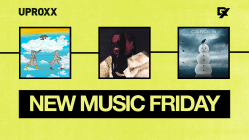“It is the ability for corporations to determine popularity—not their ability to sell a certain amount of CDs to reach a certain amount of profit—that ultimately determines the status of Empire.” – Jared Ball 1
The modern-day corporate recording industry has done one hell of a job on African America. Actually, they have done any number of hells of a job—to effectively determine what is hot and what is not.
I bet you don’t know anybody who, through hard work and dedication, worked their way to the top in the recording industry. Chances are, you don’t even know anybody who knows anybody who went from average Joe or Jane to superstardom (don’t feel bad, I don’t either). Which is interesting, considering the fact that you do know someone who can literally dance their ass off. We all know someone who can really, truly blow. So how come more off these folks don’t “make it big?”
The Entertainment Industrial Complex
In order to understand the paradox of massive community talent and miniature individual success we have to appreciate the nature, function, and purposes of the entertainment (e.g. recording) industry. The Entertainment Industrial Complex (EIC) is primarily engineered to distract (read: entertain) individuals from the fucked-upedness of their daily lives and society in general. Consider the front-page of the December 30, 2008 edition of USA Today, which contained the following headlines: A story about stock market declines, a story about Britney Spears, a college hoops update, a story about fuel shortages, a story about deaths in Gaza, a story about the decline of religious following in the United States, a story about NFL head coach firings, a story about the increasing numbers of airline flight cancellations, a story about the Obama administration offering the opportunity to win inauguration tickets, and a story about the top Hollywood box-office earners of the year. Centered on the page is a photograph of Lisa Frye, a concerned citizen from Middletown, Ohio, standing near a construction site. According to the cover story, Frye opposed an energy company’s plan to build a plant near an elementary school in Middletown. The report goes on to detail an eight-month USA Today study examining the impact of industrial pollution on schools across the nation. The newspaper identified 435 schools whose air was worse than at an Ohio school that was shut down three years earlier. That particular school had air-carcinogen levels 50 times higher than what the state authorities considered acceptable 2.
So to summarize, stories about kids who have been breathing poisoned air at school and mass death by war are situated
among stories of professional sports, celeb life, and Hollywood blockbusters. This newspaper’s front-page, (and countless others like it) celebrate stupidity by encouraging individuals to believe that the problems inherent in our collective way of life are fundamental to life itself. A newspaper full of information does not prompt individuals to ask how a story about hundreds being killed in the Middle East can be positioned right next to a story about who Brittney Spears is dating. In the end, when well-intentioned people read a story about schools with carcinogens in the air, there is no alarm and no cause for concern; much less surprise 3.
As a component of the EIC, the urban music recording industry functions in-part as a distractor from real life for millions of people a year. To a slightly greater degree than the print media, the recording industry simultaneously creates media content while effectively suppressing content that it does not sanction. In other words, determining what is not popular is just as important as determining what is popular. According to Melinda Newman of Billboard, “there are 30,000 albums released each year… [and] only 100 become hits 4.” Said more accurately, only 100 are selected to become hits. In our world, they have the power to decide what is popular and what is not. By “they” I mean Sony, Universal Music Group (UMG), Warner Music Group (WMG), and EMI who by themselves “own and disseminate over 95 percent of all music CDs sold in the Western world.5”
Their decisions are implemented in a number of ways, including routine payola practices in terrestrial, Internet and satellite radio, intellectual property rights ownership, and the structuring of artists’ record contracts themselves (for a full discussion of each of these elements, I highly recommend to the reader Jared Ball’s I Mix What I Like: A Mixtape Manifesto.) Each of these phenomena is connected to systems of other processes in a sophisticated network enabled through secrecy, greed, corruption, and psychological control. In short, this is why it is so exceptionally difficult to “break-in” to the entertainment industry.
It is common knowledge that for every talented rapper with a record deal there are 25 artists with way more talent and way less buzz. Sure, there are countless rags-to-riches tales in Rap music lyrics. And that’s the point. There is the distraction. We are encouraged to view individual success as the result of hard-work, talent, perseverance, or some other personal characteristic. We never get messages about how the EIC hand-picks artists who are safe, and then (through what is now being called artist development) make them even safer. In order to maintain its death-grip on the minds of African America, the EIC needs us to believe that we are the one’s choosing the media content broadcast over the airwaves and packaged between album covers. They need us to believe that what’s hot is what the people want.
Award shows and urban radio are key tools in the work of maintaining the illusion that real people are involved in the process of determining popularity. Award shows are the epitome of foolishness. First of all, regular people can’t get in. Only industry “insiders” are allowed anywhere near the building. Second of all, the whole envelope-opening ceremony is insulting, as (obviously) whoever put the name in the envelope are the same people producing the show. MTV, for example, has a “People’s Choice” award, which is paradoxical, since to have an award set-aside for what the people want is to acknowledge that the other 99% of awards are chosen by someone other than the people. Radio too, participates in creating the illusion of people’s choice. “Deejays” routinely give-out the station number and ask people to call in with their requests. Ever notice how they never air the callers who request something not already on their playlist? During any given week, Sony and UMG by themselves own 80-95% of the top 20 songs played across national radio6. If the people had any say in what urban radio played, then the companies couldn’t play the same 11 songs every hour. If the folks listening to Dallas K104 had any choice in the matter they wouldn’t have radio that played the same exact songs as Hot97 in New York, or WGCI in Chicago. However, award shows and fairy-tale urban radio request formats are mere child’s play compared to the most seductively persuasive method of them all: the cable “countdown” program.
“Video Soul”: The Prototype For Urban Countdown Video Shows
“Video Soul” premiered on BET during the summer of 1981 as a half-hour show. Legend has it that the program was created by BET executives as a result of MTV’s general refusal to air music videos featuring black artists. The show was a mega hit with viewers, and soon BET went to a 2-hour “primetime” format, which aired 9-11 p.m. EST. for close to 15 years. I remember “Video Soul.” I remember Donnie Simpson, and I damn-sure remember Sherry Carter. What is interesting is that the show’s run on BET almost perfectly parallels the twenty-year period between 1983 and 2003, during which the EIC went from fifty media corporations down to the control of a handful of men (all billionaire Rupert Murdoch types) you probably never heard of. Although “Video Soul” was always billed as the place for new black artists to showcase their work (GTFOHWTBS), the show didn’t evolve into the countdown format until Sherry Carter joined the show in 1992. I still remember the 1-900 number that you had to call to request the video you wanted. There was no Internet. At least not in the hood. I also seem to remember never having the video that I called-in about being played. “Video Soul” ended in 1996.
The heir apparent to “Video Soul,” “106 & Park” debuted four years later, on September 11, 2000. AJ Calloway and Free were likeable enough, their popularity eventually cemented by the daily “A-List” interviews with the likes of Jay-Z, 50-Cent, Ludacris, Nelly, Janet Jackson and Lil Bow Wow. Theirs was a dedicated countdown format, where the assumption was that callers somehow decided what videos made the countdown. Free and AJ were like well-intentioned parents who tell their kids that Santa Claus is coming to town. Their immediate successors, Big Tigger & Julissa were quickly supplanted by younger and more supple replicas Terrence J & Rocsi (who themselves were supposed to be “chosen by the people” as winners of some “New Face” contest). If AJ and Free were parents who tried to keep you young, Terrence J and Rocsi are your disgruntled cousins who didn’t get any presents and decided to burst your bubble. Does anyone really believe that somehow only songs by major label artists who have albums out are the ones being “voted” onto the countdown? And I won’t even get into the debasing caricature known as “Freestyle Friday.” Although “106 & Park” is the highest rated show in BET history, the program has lost all semblance of community authenticity. Even the name is an illusion. By naming the show after an address, its producer Stephen Hill intended to make it seem like a representation or extension of the Black and Brown community residents around E. 106th St and Park Avenue. Today, “106 & Park” isn’t even produced in Harlem anymore; now the studios are in Manhattan, a change that was made right after the network was sold to Viacom. They routinely show the hosts standing or sitting in the audience to give the impression that regular people are involved. But they are not. Regular people are, of course, at work.
Many other shows warrant mentioning here (e.g. MTV’s “Total Request Live,” “Yo! MTV Raps,” etc). What all of the above have in common is that their content is driven by the corporations, not the people. The truth is that “[w]hat we hear, see and read is only a fraction of what is produced and is owned by an ever-shrinking number of companies.7 Furthermore, despite their attempts to make these programs seem like cultural traditions (with anniversary and reunion shows, etc), they do not represent or reflect art produced for or by real people. The processes of musical selection and promotion have nothing to do with audience choice, and everything to do with corporate social control and agenda. DMX once said, “If you feed people dog shit long enough they will learn to put barbeque sauce on it.” Get Your Mind Right: Don’t let the smooth taste fool you.
1, 4, 7 Ball, J. (2011). I Mix What I Like! A Mixtape Manifesto. AK Press.
2 USA TODAY, December 30, 2008
3 Sims, B.C. Historically What? Black Nationalism, Capitalism, & Assimilation in Higher Education. Unpublished Manuscript.
5 Palast, The Best Democracy Money Can Buy, 65.
6 Ball, J. (2010). Hip-Hop and the ‘Anti-Blackness Antagonism’ Available online.











Cue pop rap apologists……NOW! Here come the “fuck this guy!” and “Hater” and “Eat a dick” comments. Here come the record sale debaters and fake image rapper nut-hangers…
Or maybe not? Mr. Sims used big words…Most of those clowns probably didn’t read half of this. And those little numbers in the story with notes at the end are called “Footnotes” kiddies. …
In the words of Ice Cube and Chuck D – “Turn off tha muthapuhckin’ radio…”
or rage against the machine song “turn on the radio nah fuck it turn off, fear is your only god on the radio nah fuck it turn it off” prison industrial complex thats a fucked up thing in itself as well.
This is all true, but what is supposed to happen? This is the result when someone has stacks of dough and wants to pay to have you see their network everyday you wake up. Nothing but having more money than the other network can help you change that.
Lemme throw out another example. Most people know Jay-Z and Dash apparently sold a super amount of copies of Reasonable Doubt from right out of the trunk. They didn’t have the dough to compete with networks at the time, so they went into the streets and thumped their own shit and sold records. That’s smart marketing against a rival whos main source is TV and radio.
Finally, I don’t like the radio either. But, I’m not ignorant enough to think the programming is gonna somehow reflect my choice of hip hop anytime soon. Unless I buy some major companies who control that shit, this is what we can expect forever. I love hip-hop, so I do my own searching for what’s good. I don’t leave it in the hands of the media.
“This is all true but what is supposed to happen?”
I’ll tell you:
Foremost, you have to OVER STAND why the entertainment and music industries are being controlled… this article, don’t get me wrong, is good. It’s very well articulated and it touches on a lot of very important points. Yet, it barely scratches the surfcace of the “great deception”.
Secondly, in answer to your question, OVER STAND that there is NOTHING you can do about this SATANIC SHIT. This deception stretches back 100’s of centuries. It’s bigger than all of us. We are but sitting ducks….
You think this shit is about money? Nah. Indeed those running the world are INSANELY wealthy, shit, they’re ROYALTY, but… the reasoning for thier principalities is much deeper and psycotic than dollar bills, yo.
I can appreciate this article for the author’s courage and impressive investigative work. But there should be more emphasis on WHY Viacom, UMG, WMG, etc are controlling what we shake our asses to, and read in the newspaper. It boils down to a spiritual war fare… I have researched and uncovered so much evidence to support that statement that if I tried to type every thing I know, I’d be typing for DAYS. In any case, understand that you’re better off doing what you been doing. Scavaging the black market, finding artists with TRUE talent in your own community because their music… wait for it… is DEVOID of the chanting and secret EVIL messages hidden on the tracks of the artist *we’ve been manipulated tricked into loving/idolizing*.
In closing, I’d just like to say to you and anyone else who comes across this article and our commentary: getting your mind right is indeed of the utmost importance. Opening your third eye is also essential. To accomplish this, we must all begin to use our minds to produce *CRITICAL THOUGHT*. The effort starts by simply asking, “why?”. What’s most important is getting to know and getting ever closer to God. Know his word. Know his promises. Prophecies long foretold are coming to a head…
Al Aqsa… LOOK IT UP!
-Skribble
Ehh… Even though I thought your reply was well written and thoughtful, it’s unsupported by any quality facts. The fact that you throw money aside as not being the main motivation is ridiculous to me. It’s the biggest tangible asset involved in this business… that’s what it is, a business.
You can talk spirituality and satanism…maybe in some twisted way its plausible, but realistically, these companies are after the money and your interest, period.
You cant OVER STAND billions of dollars in revenue with your simple word on preference of music. Unless you can build a clan of a million people to follow you.. But, get real, if a million people want what you want, then of course they’re gonna change… It’s what the people want and will make them money!
It’s all about the money, duggie..
no wolfman, lol. money is the main objects to artists and the a&r’s and shit. the owners the very few who have everything under their umbrella, illuminati (whatever, you want to call them, i dont claim to know everything)have a vested interest in changin whats popular so as to change peoples attitudes and perspectives for their own (satanic?) reasons. and i know this isn’t well written or thought out. i usually hate commenting like this cause usually it falls on deaf ears. but whatever just trying to point out mzskribblez or whatever has a way more valid point than your current knowledge will allow you to see. even though i don’t adhere to a religion. and for her i’ma add that if these guys could control everything, wouldn’t they have the ability to hijack religion there was a long ass time when no one but preachers were allowed to have bibles for however many years cause the common man wouldnt understand properly or some bullshit. like owning both sides or the coin, or both teams on the field, whatever.how come it cant be so with religion. if u turn from one path they got u on the other one vice versa. because over money its about power and control!!! although money is the best way to get or advance those things.
Sigh… It’s the 21st century, and sad to see how many people invest their beliefs in this illuminatti shit. If an article about Jay-Z goes up, you’ll see 100 posts about him being tied to illuminatti, like he rose from the ground a couple years back to take over the world.. Yet, dude was a regular dude, who grew up in a struggling situation, who made moves in the the drug game, who almost been shot and killed in the streets, etc…
It’s always the same topic of satanic worshiping and shit, but never an actual fact to support that point of view. I can read a book about satanism, it doesn’t make anything I say about it true unless I can support it with evidence. But, nah everyone wants to go posting their conspiracies around here talking about they know the truth like they met the Devil himself, pffffttttt….
I hope the newer kids are smarter than this generation, who believe anything they see on Twitter.
Very interesting discussion. Also very rare on DX comments section.
I am going to side with wolfman on this because there is no proof of Satanism and stuff.
Money isn’t what ‘they’ are after though. It is producing citizens who are completely brainwashed with the crap in the media, so that they are easy to CONTROL. It is CONTROL that they want, because Control = Power.
People who are brainwashed to not THINK but only to do their everyday jobs so that the rich can get richer and more powerful.
Wolfman & to anyone else to whom my commentary may concern:
Please, allow me to introduce myself. Most who know of me call me “Mz. Skribbleâ€. I’m a spoken word artist based out of Atlanta. I stepped on the creative scene about three years ago, and have gained a small following of like minded, and truth seeking fan base. Assuredly, knowledge of my artistry will reach your city at some point in the future.
I beseech you to not misconstrue my introduction as egotistical, overbearing or arrogant. Quite simply, I felt the introduction necessary so as to alleviate any confusion for why I come off the way I do.
Foremost, understand that my aspiration through my poetry is to awaken and “unplug†(if you will), as many minds as will listen. It is never my intention to offend, or argue. In fact, I won’t. Now, a debate… we can do that all day. But to argue with anyone, over some shit that has been proven to me as undeniable truth, I will never do. Further, understand that my loyalty lies unwaveringly to my (black) community. I swear, I all I wanna do is unplug you. I am in no way discrediting your opinion that “money is what makes the world go ‘round,†or more accurately, is the main motivator as it pertains to the music industry. I am however, asking you to dig a little deeper. I’m asking you to ask “WHY?â€. People rarely do that anymore. You have the right to ask why, but no one ever does. I’m asking you to ask yourself WHY the music, movie and media are controlled. Why we force fed the opinions of others, rather than given the liberty to come to our own conclusions. Money?? Okay, sure. But none of us, not even the Zionists, can take it with us when we die. So… beyond monetary gain, why would someone seek to control our very thoughts? Again, I tell you, essentially the reason is directly related to a spiritual ware fare.
You think Satanism is a joke, merely a theory?? Lol. Yeah, it is a conspiracy, but it aint no fucking theory. I can lay some shit out of you that would prevent you from sleeping at night. Your beloved Jay-Z, shit, you BETTA believe his ass IS ILLUMINATI. As his beautiful “wife†Beyonce. Hard to believe I know. But this is what they do…. They HAND PICK our heroes. They tell us who to love. And when they’ve accomplished that, they begin to use them….against us. We buy their music which of course makes the corporations richer, but there is a bigger motive. I shan’t divulge the motive now… I’m not ready, and truthfully, neither are you. What I’m talking about is not child’s play; one simply doesn’t blurt it out. But I will ask you to recall either a Jay-Z concert that you’ve been to, or ever watched on T.V. Do you know what that fucking pyramid means that Jay is always throwing up?? Did you ever notice that WHOLE STADIUMS will mimic the hand gesture?? Thousands of hands, in the hair, folded in a triangle. They’ve no clue what the shit means, yet they mimic it because… Jay-Z did it. And, well, because we LOVE Jay, everything he does MUST be cool. THAT’S WHAT I’M TALKING ABOUT. Throwing up that pyramid is to pay homage, respect, worship; whatever… to Satan itself. Mind you the bible tells us that Satan cannot lie to us but, he CAN AND DOES, deceive the hell out of us. Using Jay-Z and many others is but one way that Satan deceives us into worshipping him. And what about the music videos!? Lady Gaga, “born this wayâ€. You didn’t think that shit was…weird… at the VERY LEAST??? Lol… I’m just bullshitting. That video was BEYOND weird. It was… evil. Which brings me to my next point. We’ve gotta get into SYMBOLISM. Numerology. The ancient Egyptians. (I told you, the great decepion stems back 100’s of centuries). Uhhh, I digress…..
Dig this: everything, (yes I said everything), that you eat, drink, watch, enjoy, feel, love, etc… is controlled. Understand that those who run the world are AS SOPHISTICATED AS THEY ARE WICKED. Every day you wake up, you’re sleep walking and you don’t even know it. THAT’S HOW CLEVER THEIR MECHANISMS FOR MIND CONTROL ARE. Your couch is the factory where they breed brainwashed shells of humans. Your T.V. is what the old folks called the “One eyed monster†or, the “the eye that never sleepsâ€. Did you ask why they wiped out regular t.v. and told every one they HAD to switch over to digital cable? Ever think that though 3D, and HD are cool as hell, that there has to be another motive for making pictures on t.v. so clear, it’s like you can reach out and grab the images?
Before I go too far off on a tangent, I would like to commend you FOR challenging my opinion. Hell, that’s what you’re supposed to do, damnit. Don’t just believe me because I told you to. You asked, “where are the facts?†and I can respect that. In answer, to be perfectly honestly, I’m not even sure where the hell to start. Indeed I am a very thoughtful person, and it will take some time to write up a small dissertation (containing facts) for your review, Wolfman. Therefore, I’ll leave you with a promise to come back once I’ve had some time…..
Also, I’d like to leave you with an excerpt from a poem I’m currently scribing… it go like this:
“THEY PLACED OBAMA IN FRONT OF YOU WITH HIS DEBONAIR SWAG AND DR. KING SYTLE OF SPEECH,
YOU FELL FOR THE “YES WE CAN CAMPAIGN†AND BELIEVED IN HIM LIKE A PSEUDO JESUS,
THEY TOLD YOU HIS CANDIDACY WAS A TRUE SIGN OF A REVOLUTION,
THEY PLAYED WITH YOUR MIND LIKE A PIMP DOES HIS HOE RECRUITMENT.â€
I put it on your shoulder to put on your mind when you ready….
In closing, know that I am not your enemy. I do not wish to argue or raise blood pressure or none of that dumb shit that a lot of people engage in on the internet. I do not fuck with Twitter. I had an account long ago but closed it when I realized Twitter is a gigantic chat box… the people behind the screen names rarely think about what they type before they post. I don’t wish to be that interconnected. Hell, I’m on FB and that’s one social network too many. Oh, please believe social networking sites are but another method of control and spy…. But, later for that.
Until next time, Peace….
http://www.YouTube.com/Mz.Skribbe
Ok, normally I wouldn’t reply in this situation but I think others can learn something from this. I’m gonna dissect a paragraph in this biography to show how little proof is actually given.
Ms. Skribblez wrote:
“You think Satanism is a joke, merely a theory?? Lol. Yeah, it is a conspiracy, but it aint no fucking theory.”
No explanation, just opinion.
“I can lay some shit out of you that would prevent you from sleeping at night.”
Why didn’t you…?
“Your beloved Jay-Z, shit, you BETTA believe his ass IS ILLUMINATI. As his beautiful â€oewife†Beyonce. Hard to believe I know.”
Where are your facts to support the claim?
“But this is what they do…. They HAND PICK our heroes. They tell us who to love.”
You mean they pick artists that are a fit for their label and crew? Artists that could potentially be successful and therefore make them more money and popularity? Artists that make music people want to love?
“And when theyâ€(TM)ve accomplished that, they begin to use them….against us.”
Use them against us? Like what send us subliminal messages tellin us to kill our family? How do these artists get used against us? What are you talking about?
“We buy their music which of course makes the corporations richer, but there is a bigger motive. I shanâ€(TM)t divulge the motive now… Iâ€(TM)m not ready, and truthfully, neither are you. What Iâ€(TM)m talking about is not childâ€(TM)s play; one simply doesnâ€(TM)t blurt it out.”
So, you are able to type out entire paragraphs about a bigger motive, but are unable to support your claim with a single piece of evidence. Then lay out 3-4 repetitive sentences that only serve to hold you righteous and mysterious above others who are easily influenced to believe the rumors…
“But I will ask you to recall either a Jay-Z concert that youâ€(TM)ve been to, or ever watched on T.V. Do you know what that fucking pyramid means that Jay is always throwing up?? Did you ever notice that WHOLE STADIUMS will mimic the hand gesture?? Thousands of hands, in the hair, folded in a triangle.”
LOL! A triangle? Where did you do your research? The signal is a shaped as a DIAMOND. A diamond… you know the thing that women wear on their fingers. What coincidence people say, “that’s a nice ROC you’ve got.”
Retarded point, destroyed.
“Theyâ€(TM)ve no clue what the shit means, yet they mimic it because… Jay-Z did it. And, well, because we LOVE Jay, everything he does MUST be cool. THATâ€(TM)S WHAT Iâ€(TM)M TALKING ABOUT.”
Yeah, that’s what people do in stadiums and concerts to feel the music and entertainment. I supposed when people do The Wave in football stadiums, they are all conspiring to bomb another country.
“Throwing up that pyramid is to pay homage, respect, worship; whatever… to Satan itself.”
Even if that’s true… It’s a DIAMOND.
“Mind you the bible tells us that Satan cannot lie to us but, he CAN AND DOES, deceive the hell out of us. Using Jay-Z and many others is but one way that Satan deceives us into worshipping him.”
So your argument is supported by a primitive religious view about an unproven book that has floated through history… Awesome.
“And what about the music videos!? Lady Gaga, â€oeborn this wayâ€Â. You didnâ€(TM)t think that shit was…weird… at the VERY LEAST???”
So because Lady Gaga is a weirdo in a flashy clothing and gestures like she’ll fuck any toad on the street, this somehow implies she’s connected to the illuminati? That’s a bit judgemental.
“Lol… Iâ€(TM)m just bullshitting. That video was BEYOND weird. It was… evil. Which brings me to my next point.”
So far… Your points are reallllllly weak.
“Weâ€(TM)ve gotta get into SYMBOLISM. Numerology. The ancient Egyptians. (I told you, the great decepion stems back 100â€(TM)s of centuries). Uhhh, I digress…..”
What??
Ok, an entire paragraph filled with so much fluff and bullshit, and large words implied to deceive others into thinking this person has intelligence; without a single piece of credible evidence to support this EXTREME implication.
Ms. Skribblez is a perfect example of why you should have to be cleared before being allowed to write a blog to the public.
But, I digress….
lol… Silly Rabbit. They’ve tricked you, kid.
Stay tuned…. lol..
I already see this article will attract all of us INTELLECTUAL hip hoppers, in other words us boys/girls born before 1989…n @WOLFMAN, love the comment duke you said pretty much what I’ve thought since the industry went into the pooper, and since The Basement, and Yo!Mtv Raps and shit like that went off the air. N you are so very right, the almighty dollar is what rules this industry and it’s very funny how people think the people are pushing the agenda for the music we are given. ONE.
1989… pretty arbitrary place to draw the line. Lemme guess, thats the year you were born…
Hey man…don’t make that generalization….I was born in 1990. I’m 21, and I hate, I mean hate today’s music….I love underground shit though(Not fakes underground like Gucci Mane Mixtapes) I listen to Curren$y,old Lupe, and artist that try to be creative.
I called the radio to ask them to play Lupe Fiasco’s “words I never said” and it never got played. Matter of fact I have never ever heard that song on the radio and its a radio sounding song. Its the content of the first verse that makes these bastards reluctant to play the song. His other song “the show goes on” plays all day so why not “words I never said”???
I’ve heard dat song on the radio lol it’s been on for months now
Great read, but this is nothing new. I’ve worked at a radio station here in Los Angeles and have seen the results of payola behind a record.
Even when artists perform at award shows, their labels have to pay for that performance because after all, them performing in front of millions of viewers is a form of advertisement. When they are given awards, 100% of the time they are already predetermined, which means the people have NO input in the voting process. If you don’t have the financial backing, you don’t call the shots. Its as simple as that. There is little to no authenticity on a major level, thats why I stay indie!
Media used to have the ability to give the people what they wanted. I remember watching Rap City and seeing everything from A Tribe Called Quest to Biggie to Wu-Tang to Pete Rock & CL Smooth. They really did play the hottest shit that was out…
…then these crackas figured out a way to make it about them and their bottom lines instead of making it about the MUSIC and the PEOPLE! The internet is the greatest thing that could’ve happened to hip-hop (minus the album leaks, lol)
Yeah the radio shit is fucked up. Good thing for Cds and auxiliary cables.
angie martinez
funkfagster sex
dj envys
these 3 alone DESTROY our children!
everyone is on the take.
even DX accepts PAYOLA!
example: reviewed beyonce’s album after promoting the life out of it. beyonce is not a hip hop artist. yet in 2011, it’s close enough.
i’d rather listen to the sound of my brain leaking out my head than hot 97 on the ride to work.
death to all and to all a good death
not this fucking retard again…
This is a great artical
some of the comments after are just as good incase your interested.
yesss..damn near on point..corporate america has fucked us over entirely, but music is our sanction.. w/o ipods and internet – the game would really be dead..radio and tv are completely fake.
it only sucks for the kids who dont know anybetter..i was pop brainwashed till about 14..this message needs more people to expand on it!!
The one article anyone with a brain, who naturally questions authority [less common in hip-hop than you think], and seeks to be well-informed about how this industry (and to a greater extent the world) really works should read. Good work.
“The table’s tilted folks, the game’s rigged. And nobody seems to know, and nobody seems to care. That’s what THE OWNER’S count on…” – George Carlin
This is a really good article, not exactly groundbreaking but its something that unfortunately not many people know, however i think this might be a little exaggerated, as the record companies attempts to control the music isnt nearly always successful. Youtube might be the best thing to happen to music in a long time because it offers so many easy avenues to find new original good music. The new trend of artist run label companies is also a great thing for rap, because the label is run by unbiased people with a sincere love for good music. The way this article paints the industry is very bleak and almost like a communist china of music, which i think isn’t terribly far off but its a pretty strong over exaggeration. In the 80’s and 90’s we saw hip hop explode and the industry wasnt equiped to “control” the radio and as a result there was a lot of free expression and anti government and anti society music that exposed many truths about america that they try to cover up. It also exposed the trials and horrors of life in poverty in america, which has led to much more public awareness, which arose a lot from hip hop. I think after a while a couple record companies, like you said, picked some anti government rappers like tupac, and they embraced the idea of gangsta rap and violence, in an effort to get massive record sales without letting every gangsta rapper tell their saddening stories. Now my main example of this record company system failing is someone like kendrick lamar. He is not at all someone that record companies have picked, yet due to modern social networking and youtube and the way word spreads these days, hes been able to pick up a lot of steam. Now rappers can be marginally successful without even signing to a label like Odd Future, which hopefully will lead to a better future in hip hop.
My real question is, if they did play everything on the radio, how many people would truely rather listen to kendrick lamar over david guetta and flo rida’s newest terrible club song? I have tried to get some people i know to listen to more lyrical and technical and conscientious rap, and they generally respond saying something like “Yea this guy is really good…. but the beat is kinda boring”. I dont know if people have just become conditioned to the synth club beats that plague current mainstream music, or if most people truely enjoy them more for what ever reason, but i do know that even if real music was on the radio most people would still opt to listen to whats on the radio now. The saddest truth in all of this is, ignorance is bliss, people love to listen to the stuff that is spoon fed to them instead of listen to something that makes them think.
A person is open minded. People live in group think. People like what they know.
@chris Actually from my own experiences with music, radio-pop doesn’t really have as much appeal as most people think. Ever since my senior year in High School, alot of people have been opting out of bubblegum pop in exchange for Underground Hip Hop, Old School Hip Hop, Classic Rock, Shitty Rock (it’s a gateway atleast), and just better music in general.
It’s mostly tweens and young teens who like radio-pop. Although hip hop is having less success with getting people to listen to less commercial stuff. Like if you listen to BAD rock music like Linkin Park and Nickelback then atleast they can act as a gateway to get into better bands. With Hip Hop on the other hand, if you listen to Lil Wayne, there’s no gateway because his music doesn’t resemble hip hop, it’s pop, so teenyboppers will just followup by listening to more pop.
But remember one thing, Led Zeppelin sold more albums than any pop act accept Micheal Jackson!
Stopped reading after the phrase “you do know someone who can literally dance their ass off.” No one who abuses the word literally like that deserves my attention because they clearly do not have a solid grasp of the English language and therefore their editorial is irrelevant.
You should have kept reading then dumbass. So the article would have been more valid if he said really dance their ass off? take somethind in to the best of your knowledge before criticising it. you can learn anything or anyone regardless if your smarter than said thing or person. grow the fuck up.
learn from anything or anyone* incase you want to be a bitch about it.
Shut the fuck up, dumbass. You’re probably the one requesting flo’rida and drake and actually getting excited when glee comes on..the fact that you wrote a comment almost as long as the paragraph you decided wasn’t worth your time shows what an idiotic prick you are, but i already knew that from your facebook picture. What a punk. What the fuck are you doing on this site anyways? Shouldn’t you be calling in to rick dees for your daily chris brown fix? Little bitch….
Talking to you, tom kinnerfucked
I don’t know, I got mixed feelings about this. There’s some truth to it no doubt, but a few holes in it, too. Sims has this going back through 1983 but most people would agree that through about the mid-90s at least the hottest artists out were actually talented, meaning either the people have more say than the article suggests or that these evil record execs sometimes still have appreciation for genuine talent. And there’s plenty of stories of rappers who did hustle hard and make it, so unless Jay-Z is totally fabricated there can still be a genuine rags-to-riches story through talent and hard hustle.
More importantly, though, most would agree that the evil record execs are in it for money and they didn’t rob all those unsuspecting consumers. Everybody knows there’s a whole huge range of music out there and still choose to buy what’s in the top 10, meaning Flo Rida must have some kind of huge appeal even if I personally can’t understand it. I’m not willing to stop holding people responsible for what they buy, and I’m convinced if execs thought dead prez could go platinum you’d see them on 106 & Park tomorrow.
The article complains about entertainment being a distraction, but that’s only because people want to be distracted. The industry is basically a partnership between execs and willing consumers, and as long as consumers are holding up their end I don’t have much sympathy for them. All I know is I’m not buying Gucci or whoever and that works for me.
one of the most educating articles ive read on hhdx to date. glad that they are posting the nitty gritty info recently. the “em and them” article is on point too. props dx….